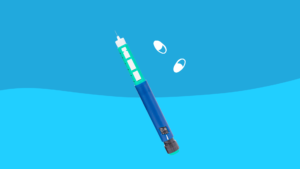Side Effects of Pioglitazone, Dosage, and Safety Profile
HOME | DIABETES EDUCATION | PIOGLITAZONE SIDE EFFECTS
Pioglitazone Side Effects
Pioglitazone, a common drug for type 2 diabetes, can improve insulin sensitivity. But, like many medicines, it can cause side effects.
Some effects may be mild and short-lived, while others can be severe and need immediate attention. Being aware of these possible outcomes is crucial for those managing diabetes.
Knowing the side effects of pioglitazone helps individuals make informed decisions about their health.
Key Takeaways
- Pioglitazone’s side effects include hypoglycemia, heart failure, weight gain, and potential bladder cancer risk.
- Monitoring for symptoms like edema, dyspnea, and jaundice is crucial during pioglitazone treatment.
- Communication with healthcare providers about side effects and concerns is essential for effective management.
- Establishing a strong partnership with healthcare providers can optimize pioglitazone treatment outcomes.
Overview of Pioglitazone Side Effects
Pioglitazone side effects include hypoglycemia (low blood sugar), hyperglycemia (high blood sugar), heart failure, weight gain, and a potential risk of bladder cancer. Monitoring blood sugar levels regularly is crucial to prevent complications. Heart failure is a serious concern, especially for older individuals using pioglitazone.
Weight gain is a common side effect. Discussing the risks and benefits with a healthcare provider is important for those prescribed pioglitazone. Promptly reporting any troubling symptoms to a healthcare professional can help manage type 2 diabetes effectively while reducing adverse effects of the medication.
Common Side Effects of Pioglitazone Medicine
Common side effects of pioglitazone medication may include:
- Sinus, throat, or chest infections
- Weight gain
- Eyesight issues
- Tingling sensation in fingers or toes
It is important to promptly seek advice from a healthcare professional if these side effects persist.
Monitoring and reporting any adverse reactions to medical providers is crucial for ensuring the proper management of the treatment plan.
Serious Side Effects to Taking Pioglitazone
Serious side effects of pioglitazone include:
- Jaundice (yellowing of the eyes or skin)
- Edema (swelling)
- Dyspnea (breathing difficulties)
- Hematuria (blood in the urine)
- Osteoporotic fractures
Immediate medical attention is necessary for these symptoms to prevent further complications.
Low Blood Sugar Symptoms
Recognizing symptoms of low blood sugar, or hypoglycemia, is crucial for individuals managing diabetes. Signs may include sweating, trembling, palpitations, and anxiety. Contributing factors include skipping meals, increased physical activity, or excessive diabetes medication.
To prevent hypoglycemia, eat regular meals, monitor blood sugar levels, and carry fast-acting carbohydrates like glucose tablets. Educating family and friends about these symptoms can help manage episodes effectively. Properly managing low blood sugar is vital for individuals with diabetes to avoid complications.
Early recognition and necessary precautions can help maintain stable blood sugar levels when using diabetes medication like pioglitazone.
Recognizing High Blood Sugar Signs
To spot high blood sugar signs, watch for increased thirst, frequent urination, fatigue, and blurred vision. These symptoms may indicate elevated blood sugar levels needing medical attention.
Unexplained weight loss, slow wound healing, and frequent infections can also suggest high blood sugar. Regularly monitoring blood sugar levels is crucial for detecting and managing high blood sugar effectively.
Ignoring persistently high blood sugar levels can lead to severe complications like nerve damage, kidney issues, and heart problems. Stay alert for these signs and promptly seek medical help if you notice any symptoms of high blood sugar.
Taking charge of monitoring blood sugar levels can help prevent potential complications linked to uncontrolled high blood sugar.
Managing Pioglitazone Long-term Effects
Individuals using pioglitazone for an extended period need to undergo regular monitoring to watch for potential long-term side effects, such as heart failure. Here are some key points to consider when managing pioglitazone long-term:
Surveillance: Continuous monitoring is crucial to detect any signs of heart failure or other adverse effects.
Elderly Patients: Those over 65 are more susceptible to specific side effects with prolonged pioglitazone use.
Safety Precautions: Considering safety measures is vital to minimize adverse effects when using pioglitazone long-term.
Periodic Assessments and Adjustment: Routine tests are essential to evaluate the effects of pioglitazone over time. Treatment adjustments may be necessary to ensure patient safety and well-being.
Uncommon Side Effects of Pioglitazone
Uncommon side effects of pioglitazone may include sinus, throat, or chest infections, eyesight problems, weight gain, and a rare pins and needles sensation in the fingers or toes. If these rare side effects persist, consult a doctor or pharmacist for guidance.
Monitoring these less common effects is crucial for overall health. Professional advice can help manage these symptoms effectively and ensure safe medication use. Addressing unusual symptoms promptly aids in understanding how pioglitazone impacts the body and well-being.
Blood Sugar Monitoring Recommendations
Proper monitoring of blood sugar levels is crucial for people taking pioglitazone to manage their diabetes effectively. Monitoring helps prevent complications like low blood sugar (hypoglycemia) and high blood sugar (hyperglycemia).
Here are some tips for blood sugar monitoring and management:
Regular Checking: Monitor blood sugar levels consistently to ensure they stay within the target range.
Special Events: Check more often when sick, stressed, or when there are changes in medication or lifestyle.
Quick Response: Keep glucose tablets or juice nearby to quickly treat low blood sugar.
Adjust Treatment: Regular monitoring helps healthcare providers make necessary changes to treatment plans, improving diabetes management and reducing the risk of complications.
Reporting Serious Side Effects
Promptly report serious adverse effects of pioglitazone, such as jaundice, sudden weight gain, edema, and breathing issues, to your healthcare provider. Additionally, be vigilant for signs like hematuria, urinary problems, and heightened risk of fractures.
Seek urgent medical attention if you encounter severe symptoms. Notify your healthcare provider promptly about any serious side effects, and in case of severe allergic reactions like dyspnea or facial swelling, seek emergency medical help without delay.
Timely reporting and intervention are crucial to effectively address these serious side effects and ensure your well-being while using pioglitazone.
Pioglitazone and Vision Changes
Pioglitazone can cause blurred vision, difficulty seeing at night, eye pain, and macular edema.
Individuals on pioglitazone need to have regular eye exams to monitor for vision changes or macular edema.
Any changes in vision or eye pain should be reported promptly to a healthcare provider for evaluation and potential adjustments to diabetes management.
Pioglitazone and Urinary Frequency
If you are using pioglitazone for treating type 2 diabetes, be aware that it may cause an increase in urinary frequency. This means you may have to urinate more often during the day, which can be bothersome and disrupt your daily routine.
Monitoring your urinary frequency while on pioglitazone is important to understand how it affects your quality of life. If the increased need to urinate becomes severe or ongoing, it is recommended to consult your healthcare provider for further evaluation and advice.
Paying attention to changes in your urination patterns and discussing any concerns with your healthcare team can ensure that you are receiving the most appropriate care while managing your diabetes with pioglitazone.
Pioglitazone and Back/Stomach Pain
If you experience back or stomach pain while taking pioglitazone, promptly notify your healthcare provider. Monitor the pain’s intensity and frequency, and seek medical evaluation if it persists or worsens.
Pioglitazone is known to derange liver function. Therefore, liver function tests should be obtained prior to starting pioglitazone and periodically thereafter. The frequency of liver function test monitoring should be based on clinical judgment. Liver function tests may improve with pioglitazone treatment in patients with nonalcoholic fatty liver disease.[13] Advise patients to seek immediate medical advice for unexplained nausea, vomiting, abdominal pain, fatigue, anorexia, or dark urine.
Your healthcare provider may need to adjust your pioglitazone treatment plan to manage these potential side effects effectively.
Importance of Healthcare Provider Communication
Maintaining a clear line of communication with your healthcare provider is crucial when taking pioglitazone for type 2 diabetes. It is important to promptly discuss any concerns or symptoms you may experience to ensure effective management of potential side effects and successful treatment outcomes.
By promptly reporting any side effects to the FDA and consulting your doctor about any serious issues, you can receive the necessary guidance and support. Your doctor may need to adjust your medication or provide additional care based on the information you provide.
Regularly monitoring your blood sugar levels and staying in touch with your healthcare team can significantly impact your overall well-being while using pioglitazone.
Establishing a strong partnership with your healthcare provider can lead to personalized care and timely interventions, improving your experience with this medication.
Frequently Asked Questions
What Is the Major Concern With Pioglitazone?
The primary concern with pioglitazone is the potential for severe side effects on the heart, bones, and urinary system. Users should watch out for symptoms like weight gain, swelling, and breathing difficulties, and seek immediate medical help if needed.
Why Is Pioglitazone Banned?
Pioglitazone is prohibited due to concerns regarding its side effects, particularly an elevated risk of bladder cancer. Regulatory measures were implemented in certain countries following safety data evaluations and risk-benefit analyses. The prohibition was justified based on considerations of public health and patient safety.
Does Pioglitazone Make You Gain Weight?
Pioglitazone can cause weight gain, especially in individuals who are overweight or have a higher body mass index. It is advisable to monitor weight regularly and seek guidance from a healthcare provider.
How Long Does It Take for Side Effects to Start?
Side effects of pioglitazone can appear within a few days to weeks after starting the treatment. It is crucial to monitor for any symptoms consistently during the therapy. Regular communication with a healthcare provider is vital for prompt identification and management of any severe side effects.



